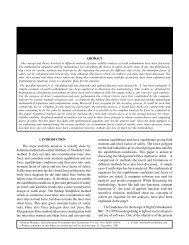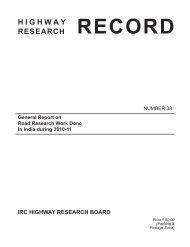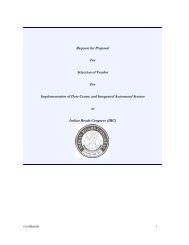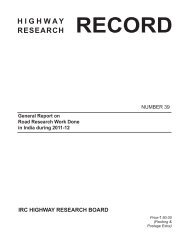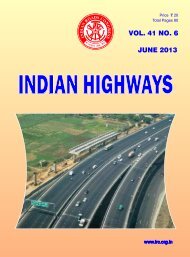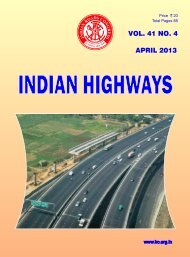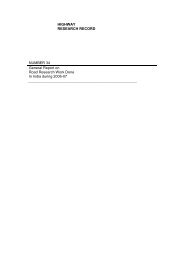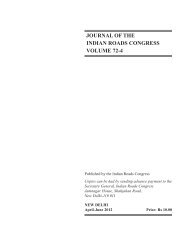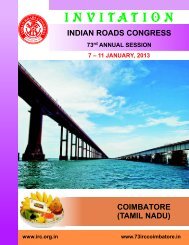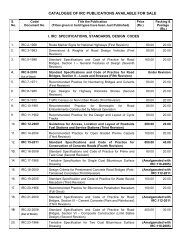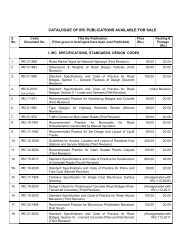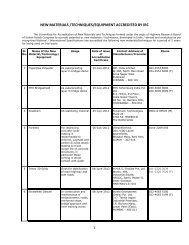A Review of Highway Agencies in the South Asia Region
A Review of Highway Agencies in the South Asia Region
A Review of Highway Agencies in the South Asia Region
You also want an ePaper? Increase the reach of your titles
YUMPU automatically turns print PDFs into web optimized ePapers that Google loves.
A <strong>Review</strong> <strong>of</strong> <strong>Highway</strong> <strong>Agencies</strong> <strong>in</strong> <strong>the</strong> <strong>South</strong> <strong>Asia</strong> <strong>Region</strong><br />
Environmental Management<br />
SANRAL activities have been certified to comply with <strong>the</strong> ISO 14001 Environmental<br />
Management System (EMP). SANRAL uses a general EMP and a site-specific EMP <strong>in</strong> all its<br />
contracts. Dur<strong>in</strong>g <strong>the</strong> plann<strong>in</strong>g phase, <strong>the</strong> prelim<strong>in</strong>ary <strong>in</strong>vestigations <strong>in</strong>clude environmental<br />
screen<strong>in</strong>g and environmental impact assessments. The higher goal <strong>of</strong> this is to contribute<br />
to <strong>the</strong> realization <strong>of</strong> <strong>the</strong> Millennium Development Goal <strong>of</strong> ensur<strong>in</strong>g environmental<br />
susta<strong>in</strong>ability<br />
The Environment Conservation Act, 1989 (Act No. 73 <strong>of</strong> 1989) regulates <strong>the</strong> control <strong>of</strong><br />
activities which may have a detrimental effect on <strong>the</strong> environment. The environmental<br />
impact assessment (EIA) process is aimed at assess<strong>in</strong>g <strong>the</strong> potential environmental<br />
impacts and <strong>the</strong> proposed mitigation measures, and to ensure that all issues, concerns<br />
and queries raised are fully documented and carried forward <strong>in</strong> <strong>the</strong> EIA process. Interested<br />
and/or affected parties can contribute and express <strong>the</strong>ir views <strong>in</strong> <strong>the</strong> process. The term<br />
‘environment’ <strong>in</strong> <strong>the</strong> context <strong>of</strong> an EIA refers to both biophysical and socioeconomic issues.<br />
Private Sector Participation and Procurement<br />
Procurement<br />
SANRAL has a management and f<strong>in</strong>ancial focus with all service delivery outsourced which<br />
<strong>in</strong>cludes design, <strong>in</strong>spection, survey<strong>in</strong>g, supervision, overload control (apart from law<br />
enforcement), traffic and safety management, and <strong>the</strong> carry<strong>in</strong>g out <strong>of</strong> ma<strong>in</strong>tenance and<br />
construction works.<br />
Procurement opportunities at SANRAL are published publicly, <strong>in</strong>clud<strong>in</strong>g <strong>the</strong> opportunities<br />
for small contractors. The publication is <strong>the</strong> start <strong>of</strong> a process <strong>of</strong> prequalification,<br />
adjudication and, f<strong>in</strong>ally, award <strong>of</strong> <strong>the</strong> contract. Social objectives <strong>in</strong> opportunities<br />
relate to <strong>the</strong> use <strong>of</strong> local labor and women, <strong>the</strong>reby comply<strong>in</strong>g with <strong>the</strong> pr<strong>in</strong>ciples <strong>of</strong><br />
<strong>the</strong> Reconstruction and Development Program. Project Liaison Committees, <strong>the</strong> ma<strong>in</strong><br />
contractor and members <strong>of</strong> <strong>the</strong> local community, are established for each <strong>of</strong> <strong>the</strong>se projects<br />
to oversee <strong>the</strong> socioeconomic requirements.<br />
SANRAL’s procurement policy is aimed at stimulat<strong>in</strong>g growth <strong>of</strong> SMEs, promot<strong>in</strong>g Black<br />
Economic Empowerment and tra<strong>in</strong><strong>in</strong>g for historically disadvantaged <strong>South</strong> Africans. In<br />
particular for rout<strong>in</strong>e road ma<strong>in</strong>tenance, SANRAL revisited its model contract result<strong>in</strong>g <strong>in</strong> a<br />
situation where:<br />
The ma<strong>in</strong> contractor operates as a management contractor while 80 percent <strong>of</strong> <strong>the</strong> work<br />
or more carried out by small contractors; <strong>the</strong> ma<strong>in</strong> contractor is responsible for tra<strong>in</strong><strong>in</strong>g<br />
and mentor<strong>in</strong>g <strong>the</strong> subcontractors;<br />
Consult<strong>in</strong>g eng<strong>in</strong>eers are hired for <strong>the</strong> design and supervision <strong>in</strong> addition to a SANRAL<br />
road manager;<br />
Low entry barriers for small contractors are ma<strong>in</strong>ta<strong>in</strong>ed; and<br />
There is no exploitation <strong>of</strong> small contractors.<br />
Public Private Partnerships<br />
Over <strong>the</strong> past 10 years, SANRAL has successfully completed three PPPs: N4 Maputo<br />
Development Corridor, <strong>the</strong> N3 Toll Road, and <strong>the</strong> N4 Plat<strong>in</strong>um <strong>Highway</strong>. These toll roads are<br />
f<strong>in</strong>anced and ma<strong>in</strong>ta<strong>in</strong>ed by private sector companies. No fund<strong>in</strong>g is undertaken by SANRAL<br />
for <strong>the</strong>se projects and <strong>the</strong>y do not form part <strong>of</strong> <strong>the</strong> balance sheet. SANRAL applies, <strong>in</strong>ter<br />
alia, <strong>the</strong> BOT model or variants <strong>the</strong>re<strong>of</strong>. The concessionaire is required to fund, design, build,<br />
operate and ma<strong>in</strong>ta<strong>in</strong> <strong>the</strong> road for <strong>the</strong> duration <strong>of</strong> <strong>the</strong> concession period. In this <strong>in</strong>stance,<br />
<strong>the</strong> toll revenue accrues to <strong>the</strong> account <strong>of</strong> <strong>the</strong> concessionaire. The Model Concession<br />
Agreement (over a 30-year term) sets out a precise and regulatory framework to reduce<br />
uncerta<strong>in</strong>ties, and apportion risks and rewards between public and private partners. As a<br />
result, additional resources are available from <strong>the</strong> fiscus for non-toll roads and ensure an<br />
economically balanced national road network. Fur<strong>the</strong>rmore, it allows for <strong>the</strong> <strong>in</strong>tegration <strong>of</strong><br />
new technologies such as IMS and Intelligent Transport System <strong>in</strong> <strong>the</strong> pursuit <strong>of</strong> reduc<strong>in</strong>g<br />
congestion, and <strong>in</strong>creased road safety.<br />
119



